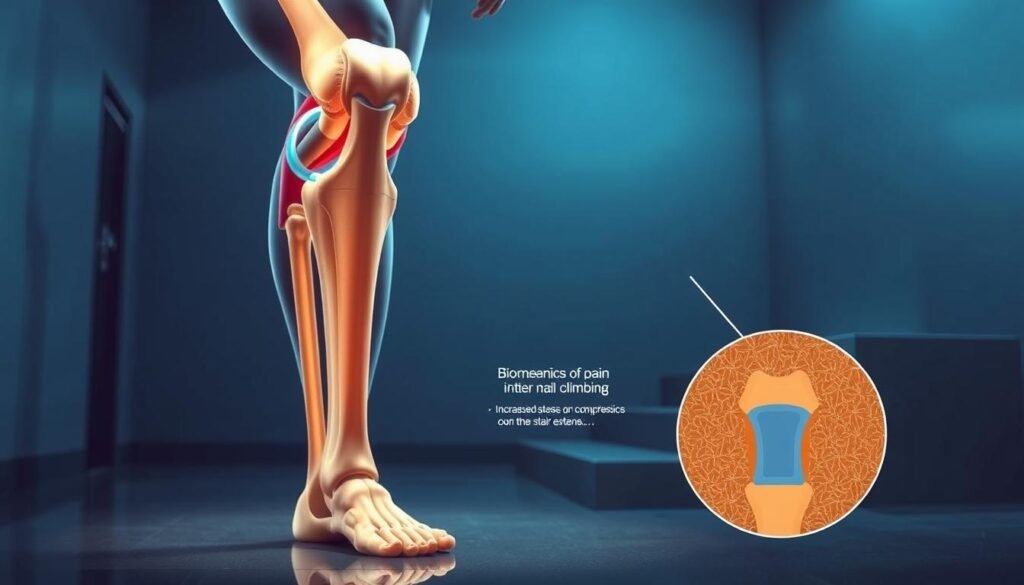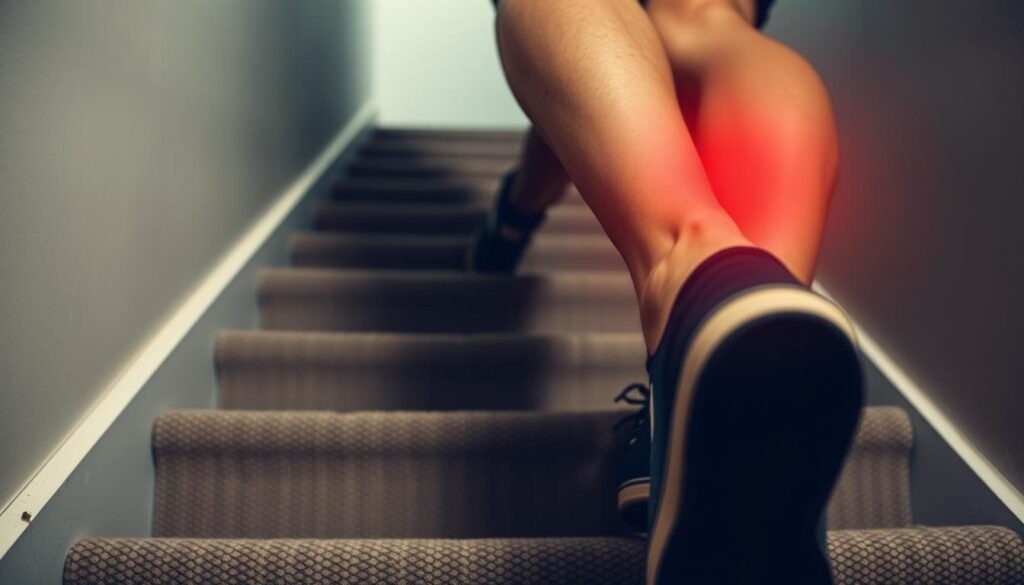
Why does a simple stair climb turn into a painful ordeal for so many? For active individuals, this common struggle often signals deeper issues within the joint. Our knees endure immense stress during daily movements, and stair climbing magnifies pressure on critical structures like the kneecap and surrounding tissues.
Research from Medical News Today highlights that softened cartilage beneath the kneecap—a condition called chondromalacia—is a frequent culprit. Overuse, misalignment, or muscle imbalances can accelerate wear and tear, triggering discomfort. The knee’s complex design, involving bones like the femur and tibia, relies on stable ligaments and healthy cartilage to function smoothly.
This article examines how inflammation, structural irregularities, and weakened muscles contribute to the problem. We’ll also explore practical strategies to address symptoms, from targeted exercises to medical interventions. Early action not only eases discomfort but can prevent long-term damage.
Key Takeaways
- Chondromalacia (softened kneecap cartilage) often causes discomfort during stair climbing.
- Muscle weakness or alignment issues increase strain on the joint.
- Early intervention helps reduce symptoms and protect long-term mobility.
- Home remedies like ice and stretching can provide quick relief.
- Professional treatments address underlying structural problems effectively.
Understanding the Knee Anatomy and Its Role in Stair Climbing
Stair navigation demands precise coordination of joint components. Three bones form this critical hinge: the femur (thigh bone), tibia (shin bone), and patella (kneecap). These structures work with shock-absorbing cartilage and crescent-shaped menisci to distribute body weight evenly during movement.
Key Bones, Cartilage, and Menisci
The patella glides along a groove in the femur during bending motions. Healthy articular cartilage prevents bone friction, while menisci act as natural cushions. Damage to these tissues—like a meniscus tear—disrupts smooth motion, making stairs challenging.
Muscles, Ligaments, and Joint Dynamics
Quadriceps and hamstrings provide power for ascending steps. Ligaments like the ACL and MCL prevent excessive twisting or shifting. Weakness in these muscles or laxity in ligaments can alter joint alignment, increasing strain on vulnerable areas.
Understanding this interplay helps pinpoint why discomfort arises. A physical therapist can assess individual biomechanics to identify imbalances contributing to stair-related issues. This foundation prepares us to explore specific triggers and solutions in later sections.
Knee pain when climbing stairs: Underlying causes
Daily movements like ascending steps demand more from our bodies than we realize. Repetitive motions strain delicate structures, especially if imbalances exist. Research from Medical News Today shows 43% of adults experience joint discomfort linked to overuse or poor alignment.
Overuse, Misalignment, and Inflammation
Frequent stair climbing increases pressure on the kneecap’s cartilage. This can lead to chondromalacia, where softened tissue causes grinding sensations. Weak thigh muscles or hip imbalances often contribute to misalignment, creating uneven wear.
Inflammation frequently develops as tendons and ligaments work harder to stabilize the joint. Even minor swelling reduces mobility, making each step feel stiff or unstable.
Injuries and Degenerative Factors
Past traumas like a meniscus tear weaken the joint over time. Age-related cartilage thinning also plays a role. By age 50, many adults show early signs of degeneration, according to orthopedic studies.
| Cause | Impact | Solution |
|---|---|---|
| Repetitive Stress | Inflamed tendons | Activity modification |
| Muscle Weakness | Joint instability | Targeted exercises |
| Previous Injury | Accelerated wear | Physical therapy |
Early intervention matters. A physical therapist can design routines to strengthen supporting muscles, slowing damage. Simple changes—like reducing stair use during flare-ups—often provide immediate relief while long-term strategies take effect.
Recognizing Symptoms and When to Seek Help
Our bodies send clear signals when something’s wrong—if we learn to listen. Joint discomfort during daily tasks often starts subtly but escalates without intervention. Recognizing early signs can mean the difference between simple fixes and chronic issues.

Identifying Common Symptoms During Stair Climbing
A dull ache around the kneecap after activity often hints at cartilage irritation. Swelling or clicking sounds when bending the joint might suggest inflammation or soft tissue damage. Crepitus—that unsettling grinding sensation—could signal thinning protective layers between bones.
Pay attention to stiffness after sitting or sharp twinges mid-step. These often worsen with repetitive motions like stair use. Research from Hinge Health notes that instability—feeling your joint might “give out”—requires immediate attention.
Indicators for Professional Evaluation
Persistent discomfort lasting over two weeks warrants a clinical assessment. Difficulty bearing weight or sudden mobility loss could indicate meniscus tears or ligament damage. Physical therapists use targeted tests to pinpoint issues like patellar misalignment or muscle imbalances.
Early detection opens doors to effective treatment options, from custom exercises to anti-inflammatory strategies. Ignoring symptoms risks accelerating cartilage wear or inviting chronic conditions. Schedule an evaluation if rest and ice fail to bring relief within days.
Practical Home Remedies and Lifestyle Adjustments
Taking control of joint health starts with simple daily choices. Small changes in movement patterns and nutrition can significantly ease strain during stair navigation while promoting long-term mobility.
Low-Impact Exercises and Strengthening Routines
Hinge Health studies show water-based activities like swimming reduce impact by 75% compared to running. Try these 10-minute daily routines:
- Semi-squats: Hold a chair for support while lowering halfway
- Step-ups: Use a 6-inch platform to mimic stair motion safely
- Straight leg raises: Strengthen quadriceps without bending the joint
Diet, Weight Management, and Supportive Strategies
Every pound lost removes four pounds of pressure from the joint, according to Medical News Today. Focus on anti-inflammatory foods like salmon and walnuts while avoiding processed sugars.
| Strategy | Benefit | Example |
|---|---|---|
| Low-Impact Exercise | Strengthens muscles | Swimming 3x weekly |
| Weight Management | Reduces load | Portion-controlled meals |
| Supportive Footwear | Improves alignment | Orthotic inserts |
Pair these efforts with gentle calf stretches after prolonged sitting. Track symptom changes weekly—improved stair comfort often appears within 21 days of consistent practice.
Physical Therapy and Targeted Exercise Strategies
Regaining strength and mobility often begins with smart movement strategies. Hinge Health research reveals that 78% of patients report improved comfort during daily activities after starting guided exercise plans. These programs address muscle imbalances while protecting vulnerable joints.
Customized Exercise Programs and Stretching
A tailored routine might include step-ups to mimic stair motion without strain. Therapists often prescribe controlled leg raises to strengthen quadriceps—key muscles supporting the kneecap. “Consistency matters more than intensity,” notes Dr. Emily Carter, a sports medicine specialist. Three proven approaches:
- Glute bridges to stabilize hips
- Hamstring stretches with resistance bands
- Wall sits to build endurance
These moves target often-overlooked muscle groups that influence joint alignment. Virtual therapy options now let patients receive real-time feedback at home.
The Role of a Physical Therapist in Joint Health
Professionals assess gait patterns and flexibility to design personalized plans. One study showed early intervention reduces surgical needs by 62% in cases of patellofemoral discomfort. Therapists track progress through:
| Metric | Improvement Goal |
|---|---|
| Range of Motion | 15% increase in 6 weeks |
| Pain Scale Rating | Reduce by 50% monthly |
Regular sessions help adjust exercises as strength improves. This proactive approach builds resilience for long-term joint health.
Advanced Treatment Options and When to Consider Surgery
Modern medicine offers multiple pathways to address persistent joint issues when initial approaches fall short. After exploring lifestyle changes and physical therapy, targeted interventions can provide relief while protecting long-term mobility.
Medication, Orthotics, and Noninvasive Methods
Over-the-counter NSAIDs like ibuprofen help reduce swelling and discomfort during flare-ups. Custom knee braces stabilize the joint during demanding activities, while orthotic shoe inserts correct alignment issues originating from foot mechanics. Medical News Today reports 68% of patients achieve significant improvement through these methods alone.
Consider these evidence-backed approaches:
- Topical creams: Capsaicin-based formulas block pain signals
- Compression sleeves: Improve circulation during recovery
- Gait analysis: Identifies movement patterns needing correction
| Treatment | Purpose | Success Rate |
|---|---|---|
| Custom Orthotics | Alignment correction | 74% |
| Corticosteroid Injections | Inflammation reduction | 82% (short-term) |
| Platelet-Rich Plasma | Tissue regeneration | 63% |
Surgical solutions become necessary only when cartilage loss exceeds 50% or structural misalignment resists conservative care. Arthroscopic procedures repair damaged tissue, while realignment surgeries address chronic instability. Always consult multiple specialists before choosing invasive options—studies show 89% of cases resolve without operating room intervention.
Our goal remains clear: preserve natural joint function through personalized care. Regular monitoring ensures treatments evolve with your needs, keeping daily activities comfortable and sustainable.
Conclusion
Addressing joint discomfort starts with understanding its roots. We’ve explored how cartilage wear, muscle imbalances, and alignment issues create strain during daily movements. Recognizing early symptoms like stiffness or swelling allows for quicker action—often preventing long-term damage.
Conservative approaches make a significant difference. Targeted exercises strengthen supporting muscles, while lifestyle changes reduce pressure on vulnerable areas. For those needing extra support, our detailed breakdown of common triggers offers practical solutions tailored to individual needs.
Severe cases might require advanced interventions, but research shows most people improve through consistent care. Simple strategies—proper footwear, weight management, and modified activities—build resilience over time. If discomfort persists beyond two weeks, consult a specialist to explore personalized treatment plans.
Every step toward better joint health matters. With the right knowledge and proactive measures, reclaiming pain-free movement becomes an achievable goal. Start today—your future self will thank you.
